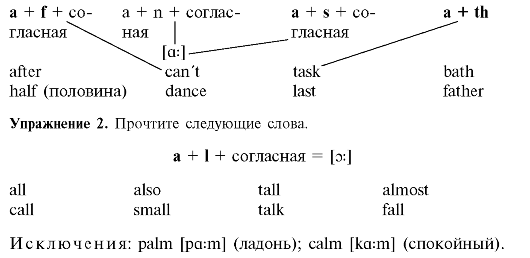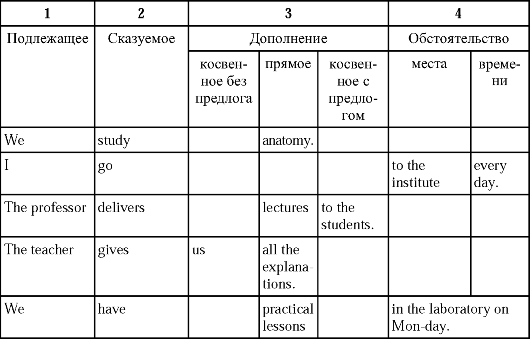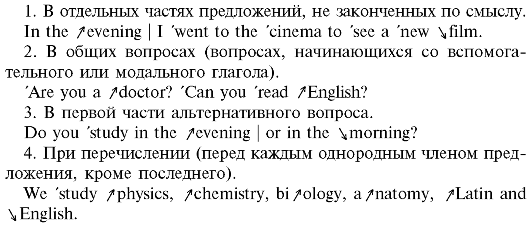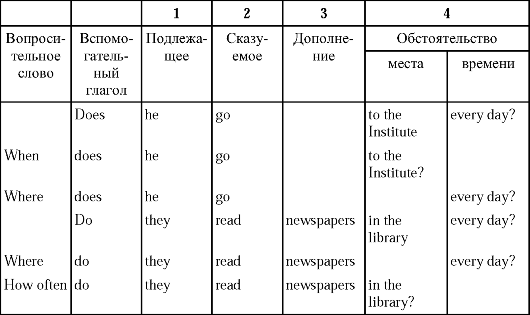Английский язык : учебник / И. Ю. Марковина, З. К. Максимова, М. Б. Вайнштейн; - 4-е изд., испр. и перераб. - 2010. - 368 с.
|
|
|
|
УРОК 4 КАКИЕ СОЧЕТАНИЯ АНГЛИЙСКИХ ГЛАСНЫХ И СОГЛАСНЫХ ДАЮТ ДОЛГИЕ ЗВУКИ
Упражнение 1. Прочтите следующие слова.

Упражнение 3. Прочтите следующие пословицы и поговорки. Выберите и переведите 4 из них.
1.
All is well that ends well. 2. Speaking without thinking is shooting
without aim. 3. Be slow to promise and quick to perform. 4. It is never
too late to learn. 5. Never try to kill two birds with one stone.
Упражнение 4. Прочтите текст и переведите его. Скажите, в каком времени употреблены выделенные глаголы-сказуемые.
An old man and sailor (моряк) were once having a talk. The old man asked the sailor where his father had died (умирать). The sailor answered that his father and his grandfather and his grandfather's father had all died at sea.
Then the old man said that the sea must be a dangerous (опасный) place, and asked whether the sailor was not afraid of going to sea (не боится ли он отправляться в море). The sailor said that he was not at all afraid, and
asked where the old man's father, grandfather and his grandfather's
father died. The old man answered that they had all died in their beds.
The sailor then said that a bed must be a dangerous place, and asked the old man whether he was not afraid of going to bed.
СТРОГИЙ ПОРЯДОК СЛОВ, ИЛИ «ЧЛЕНЫ ПРЕДЛОЖЕНИЯ ДОЛЖНЫ БЫТЬ НА МЕСТАХ»
Для английского предложения характерен твердый порядок слов, т.е. каждый член предложения имеет свое определенное место. К этому привело отсутствие развитой системы родовых, падежных и личных окончаний. Грамматические отношения между словами в предложении выражаются главным образом при помощи порядка слов и предлогов. Так, в простом распространенном предложении подлежащее с определениями стоит до сказуемого, за сказуемым следует дополнение. Обстоятельство, как правило, занимает место после дополнения. Вспомним высказывание А.Н. Толстого: «Члены предложения должны быть на местах: острота фразы должна быть в точности определения существительного, движение фразы - в психологической неизбежности глагола».
В русском языке благодаря наличию падежных окончаний мы можем переставлять члены предложения, не меняя основного смысла высказывания. Например, предложения: Студенты изучают анатомию и физиологию и Физиологию и анатомию изучают студенты - совпадают по смыслу. В английском языке такие перестановки невозможны. Возьмем предложение The students study anatomy and physiology. Если подлежащее и дополнение поменять местами, то получится бессмыслица: Anatomy and physiology study the students. Анатомия и физиология изучают студентов. Произошло это потому, что слова anatomy and physiology, попав на первое
место, стали подлежащим, т.е. активным деятелем предложения, а слово students, став дополнением, превратилось в объект действия.
Порядок слов в английском утвердительном предложении

Упражнение 5. Прочтите и переведите следующие предложения, пользу- ясь схемой порядка слов в английском предложении.
1.
Cocaine, a local anaesthetic, was discovered in the nineteenth
century. 2. When the problem of pain was solved, the surgeons could
carry out complicated operations. 3. The French chemist, physicist and
bacteriologist Louis Pasteur discovered the «germ theory» of disease.
4. Robert Koch worked in the field of bacteriology and immunology.
Упражнение 6. 1) Прочтите текст и переведите выделенные слова. 2) Просмотрите текст. Найдите в тексте ответы на следующие вопросы.
1.
When was steady progress made in the health-related sciences? 2. What
did G.B. Morgani explain? 3. What did Rene Laennec invent? 4. What do
you know about the vaccination for smallpox? 5. What anaesthetics are
used to relieve pain during operation?
The Rebirth of Science
The eighteenth century was a period during which steady progress was made in the health-related sciences. New discoveries were made in
physics, chemistry, anatomy, biology, physiology, bacteriology and other sciences.
The beginning of new theories of disease was stimulated by the first great pathologist Giovanni
Battista Morgagni who explained the connection of the symptoms of
disease in the living body with anatomical findings at autopsy. The
English naval surgeon James Lind discovered the ways to treat scurvy (цинга). The great anatomist John Hunter became known as the founder of scientific surgery. The French physician Rene Laennec, with his invention of the stethoscope, extended the development of physical diagnosis, begun by Leopold Auenbrugger.
At the end of the century immunology was introduced in the field of health conservation (сохранение здоровья).
In 1776 the vaccination for smallpox (оспа) was discovered in
In 1799 Sir Humphry Davy discovered that nitrous oxide, or «laughing gas», helped to relieve pain when breathed into the lungs and could make people temporarily (временно) unconscious. Forty years later Michael Faraday found that ether (эфир) had the same effect, and in
ГЛАГОЛ ВО ГЛАВЕ УГЛА
Продолжим нашу беседу о строгом порядке слов в английском предложении. Как справедливо отмечает М.А. Колпакчи, русскую фразу можно сравнить с автобусом или самолетом, которые в движении не скованы рельсами.
Английская фраза подобна трамваю или поезду, которые движутся по рельсам. Малейшее отклонение от рельсов в сторону равносильно катастрофе.
Главные члены предложения - подлежащее и сказуемое. Они образуют основу того или иного высказывания. Все остальные слова любого предложения зависят от главных членов предложения. Они поясняют, дополняют подлежащее и сказуемое. К второстепенным членам предложения относятся дополнения и обстоятельства.
Особая роль в английском предложении принадлежит глаголусказуемому. Само его название говорит об особой значимости сказуемого: сказуемое - от слов сказывать, рассказывать. Глагол все-
гда стоит после подлежащего, занимая в повествовательном предложении второе место. Именно глагол превращает существительное в живое выражение мысли. В английском языке нет предложения без глагола-сказуемого.
В книге Г.П. Данилевского «Княжна Тараканова» мы читаем короткое письмо графа Орлова, победителя при Чесме, своему брату Григорию: «Государь, братец, здравствуй! За неприятелем мы пошли, к нему пришли, схватились, сразились, победили, потопили, сожгли и в пепел обратили. А я, ваш слуга, здоров. Алексей Орлов». Все выражено восемью глаголами, кратко, стремительно.
Другим примером может служить фраза, сказанная Юлием Цезарем: «Veni, vidi, vici.» (Пришел, увидел, победил.) - Всего три глагола, но ими сказано очень много.
Упражнение 7. Составьте предложения из следующих слов. Помните, что глагол всегда стоит после подлежащего.
1. the Institute, this year, entered,
ИНТОНАЦИЯ
В английском языке, как и в русском, различают две основные речевые мелодии: с понижением тона и с повышением тона. Мелодия с понижением тона употребляется при законченности высказывания, выражении категоричности. Мелодия с повышением тона указывает на незаконченность высказывания.
В английском предложении первый ударный слог всегда самый высокий по тону, а все последующие ударные слоги на тон ниже предыдущего, причем понижение или подъем голоса происходит только на последнем ударном слоге.
Основные случаи употребления мелодии с понижением тона
1. В законченных повествовательных предложениях, выражающих утверждение или категоричность заявления.


Основные случаи употребления мелодии с повышением тона

Упражнение 8. Прочтите текст, соблюдая интонацию повествовательных и вопросительных предложений. Переведите текст на русский язык.
The patient was very sick. «Doctor,»
he said, «cure me and I'll give 5000 dollars to this hospital.» It was
a difficult case, but the doctor cured the man. Two weeks later the
doctor met the man and said:
«How
are you?» «I am well, thank you.» «I want to speak to you,» said the
doctor, «about the money you promised to the hospital.» «Oh! Now you
can see how really sick I was.»
ВОПРОСЫ В АНГЛИЙСКОМ ЯЗЫКЕ
Вопросы бывают четырех типов: общие, специальные, альтернативные и разделительные.
Общими вопросами называются такие, на которые можно ответить yes или по. Такие вопросы начинаются с вспомогательного глагола. Например:
Do you study anatomy at the Institute? Yes, I do. Did you study Latin last year? No, I didn't.
Специальные вопросы имеют целью выяснение какого-либо факта или обстоятельства. Они относятся к одному из членов предложе-
ния и начинаются с вопросительного слова. Запомните следующие вопросительные слова: who кто? что? какой?, where где? куда?, when когда?, why почему?, how как?, how many, how much сколько?, how long как долго? сколько?, what for зачем?
Where do you study? I study at the
When do you come to the Institute? I come to the Institute at 8.50.
Альтернативные (выборочные) вопросы имеют целью выяснение отдельных подробностей высказывания. Такие вопросы по структуре похожи на общие вопросы и требуют полного ответа. Говорящему предлагается выбор одного из двух возможных вариантов. Например:
Do you study anatomy or surgery in the first year? We study anatomy in the first year.
Do you live in
Разделительные вопросы имеют целью уточнение того или иного факта или обстоятельства и требуют краткого ответа. Например:
You study English, don't you? (Вы изучаете английский язык, не правда ли?) Yes, I do.
You had no lecture at 5 o'clock, had you? (У вас не было лекции в 5 часов вечера, не так ли?) No, we hadn't.
Порядок слов в вопросительном предложении

Упражнение 9. Поставьте общие вопросы к данным предложениям. Дайте ответы на заданные вопросы.
Образец: Professors deliver lectures at the Institute.
Do professors deliver lectures at the Institute? Yes, they do.
1.
They have two children. 2. She has a brother. 3. The students are in
the reading-hall. 4. My friends will go to the theatre tomorrow. 5. She
went home an hour ago.
Упражнение 10. Поставьте специальные вопросы к следующим предло- жениям. Начинайте вопрос с вопросительного слова, данного в скобках.
Образец: I read books every day (what) What do I read every day?
1.
She reads very quickly. (how) 2. I entered the Institute at the age of
18. (when) 3. He usually spends his holidays in the country. (where)
4. They will go to the Institute in the morning. (who) 5. We wake up at
seven o'clock in the morning. (when)
Упражнение 11. Поставьте вопросы к выделенным словам.
1. My brother entered the Institute last year. 2. We shall graduate from the Institute in six years. 3. All our students take an active part in social life. 4.
Упражнение 12. Поставьте вопросы ко всем членам предложения.
1. Не is nineteen years old. 2. I shall become a doctor in six years.
Упражнение 13. Ответьте на следующие вопросы.
1. Are you a student of the Medical Faculty? 2. You live in
Упражнение 14. 1) Прочтите текст про себя и скажите, какие открытия были сделаны в области медицины в XIX веке? 2) Ответьте на следующие вопросы.
1.
Cocaine was very effective as a local anaesthetic, wasn't it? 2. Who
is the originator of the germ theory of disease? 3. What is
pasteurization? 4. Did Roentgen discover X-rays or some other rays?
Rapid Scientific Advances
Great
discoveries were made in the nineteenth century. One of them was the
discovery of cocaine, which was very effective as a local anaesthetic.
Surgeons could inject cocaine into a certain part of the body and
deaden (заглушать) the pain in that part during the operation.
When the problem of pain was solved, surgeons could carry out long and complicated operations.
A
very important discovery was made by the French chemist, physicist and
bacteriologist Louis Pasteur. We know him as the originator of the
«germ theory» of disease. He discovered fermentation and developed the
process of pasteurization. Louis Pasteur produced the theory that
disease and infection were caused by germs and he proved that they were
spread through the air. He found that germs could be killed in the
liquids (жидкостях) by heat (теплом) and the term «pasteurization» was given to this process. Milk is treated in this way today to make it safe to drink.
Rudolf
Virchov became known for his work in cellular pathology, and Herman von
Helmholtz for his invention of the ophthalmoscope in 1850. Lord Joseph
Lister introduced antiseptic surgery in 1867, and Wilhelm K. Roentgen
discovered X-rays in 1895. He placed his hand in front of the apparatus
and saw that the rays passed through the hand and cast a shadow (тень) of bones on the screen (экран). Because he did not know what the rays were he called them X-rays.
Упражнение 15. 1) Прочтите и запомните следующие слова.

2) Прочтите про себя первые два абзаца текста. Найдите и прочтите вслух эквиваленты следующих сочетаний слов.
двадцатое столетие, лечение и предупреждение заболевания, группы крови, хорошо составленная диета
3) Прочтите и переведите абзацы 3, 4, 5. При чтении соблюдайте правила паузации и интонации.
4) Прочтите и переведите, пользуясь словарем, абзацы 6, 7.
The Developments of the Twentieth Century
1.
During the first seventy years of the twentieth century many
discoveries were made in the treatment and prevention of disease. In
1901 Kari Landsteiner discovered the blood groups.
2. Some diseases are not caused by germs or infections but by the lack (недостаток, нехватка) of certain substances in our food. The discovery of vitamins in 1912 was very important to provide (обеспечить) people with a properly balanced diet.

6. During
the two world wars, great advances were made in the field of plastic
surgery, in which skin, bone, or muscle was taken from one part of the
body and then was transplanted to a badly injured area in another part.
7. Great
progress was made in the prevention and treatment of cardiovascular
diseases, cancer, bacterial and viral infections; Renovation methods of
diagnosing such as CT (computer tomography), MRT (magnetic resonance
tomography), ultrasonography have been developed.
КОНТРОЛЬНО-ОБОБЩАЮЩИЕ УПРАЖНЕНИЯ
Упражнение 16. 1) В каком столбике во всех словах есть нечитающиеся буквы? 2) В каком столбике везде содержится звук [о:]? 3) В каком столбике везде содержится звук [α]?

(Ответы: 1) d; 2) с; 3) b. Если вы ошиблись, повторите правила чтения на с. 24, 32)
Упражнение 17. Укажите, в каких предложениях выделенное слово явля- ется сказуемым.
1. The study of anatomy is very important. 2. The bones form the skeleton of the body. 3. Bones of the skeleton have many forms. 4. Physiologists study the functions of the body. 5. The Latin word «cranium» means the skull. 6. An experiment is a means of investigation.
(Ответы: 2, 4, 5. Если вы ошиблись, см. с. 35)